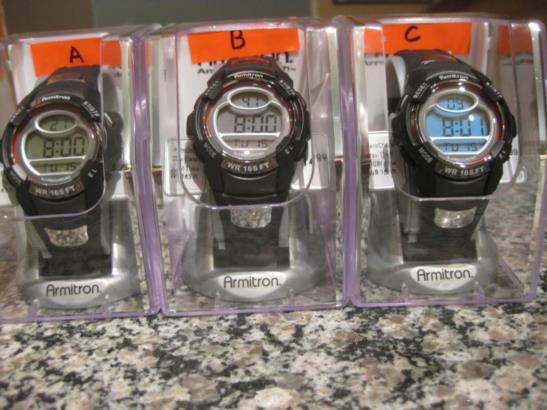
NavList:
A Community Devoted to the Preservation and Practice of Celestial Navigation and Other Methods of Traditional Wayfinding
From: UNK
Date: 2009 Sep 15, 02:22 -0700
Based on our discussion, I became curious about the accuracy of digital watches and their suitability for use as chronometers so I went to my local TARGET store and purchased three identical watches for $17.00 each, the cheapest that they had. I set them and let them run for a few days and, as I expected, they each had different rates. Based on this I labeled them "A", "B", and "C" in the order of their rates starting with the slowest. I then reset them to UTC at 0121 Z on May 28, 2009. I checked them against UTC from WWV eleven days later on June 8th and found that they were all running fast by 2, 4 and 7 seconds respectively and I worked out their daily rates as .1818, .3636, and .6363 seconds per day, respectively. On July 11th, 44 days after starting the test, the watches were fast by 9, 17 and 28 seconds. Using the rates determined in the first 11 days the predicted errors would have been 8, 16 and 28 amounting to errors in prediction of 1, 1, and 0 seconds. If using these three watches for a chronometer we could average the three errors and end up with only a .66 second error in the UTC determined by applying the daily rates to the three displayed times after 33 days from the last check against WWV which took place on June 8th. I determined new rates now based on the longer 44 day period of .2045, .3864 and .6363 seconds per day, respectively. On September 15th at 0800 Z (per WWV), 110 days after starting the test, I took a photo of the watches which I have attached. The photo shows the watches fast by 21, 41 and 69 seconds but by carefully comparing them individually with the ticks from WWV the estimated actual errors are 21.5, 41.8 and 69.0 seconds. Using the 44 day rates, the predicted errors are 22.5, 42.5, and 70 seconds giving the errors in the predictions of 1.0, 0.7 and 1.0 seconds which, if averaged, would have caused a 0.9 second error in the computed UTC after 66 days from the last check against WWV on July 11th. If, instead, I used the 11 day rates then the predicted errors would have been 20.0, 40.0, and 70.0 seconds which would result in errors of prediction of -1.5, -1.8, and 1.0 which, if averaged, would cause and error in the computed UTC of -0.6 seconds after 99 days from the last check against WWV which would have been on June 8th in this example. From this experiment it appears that fifty one dollars worth of cheap watches would give you a perfectly adequate chronometer. gl --~--~---------~--~----~------------~-------~--~----~ NavList message boards: www.navlist.net Or post by email to: NavList@navlist.net To , email NavList-@navlist.net -~----------~----~----~----~------~----~------~--~---







